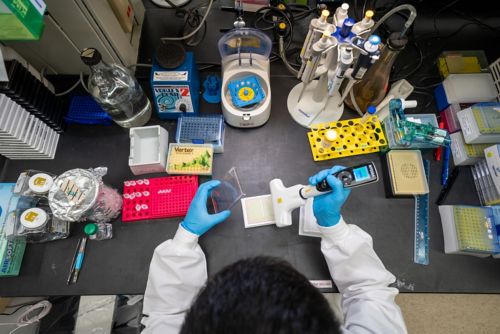St. Jude Family of Websites
Explore our cutting edge research, world-class patient care, career opportunities and more.
St. Jude Children's Research Hospital Home

- Fundraising
St. Jude Family of Websites
Explore our cutting edge research, world-class patient care, career opportunities and more.
St. Jude Children's Research Hospital Home

- Fundraising
Liver toxicity and ALL: Genomics drive variability between patients

Researchers at St. Jude Children’s Research Hospital conducted a study to identify inherited genetic variants contributing to liver toxicity in children treated for acute leukemia.
The use of chemotherapy to cure cancer is among the greatest medical achievements. Yet, chemotherapy can be a harsh treatment that affects the body in many ways. In medicine, toxicity refers to something that causes harm or unwanted side effects. Scientists at St. Jude Children’s Research Hospital are working to understand better why some children with cancer experience certain toxicities from chemotherapy while others do not, even if they receive the same treatment.
Acute lymphoblastic leukemia (ALL) is the most common childhood cancer. ALL can occur in B cells (B-ALL) or T cells (T-ALL), different types of cells found in the blood. New research from the laboratory of Jun J. Yang, PhD, St. Jude Departments of Oncology and Pharmacy and Pharmaceutical Sciences, studied the genomics of both B-ALL and T-ALL to shed light on liver toxicity after chemotherapy.
The liver is like a filter in the body. Blood passes through the organ breaking down or balancing nutrients and metabolizing drugs or other substances. Something that is hepatotoxic causes harm to the liver. Hepatotoxic effects that can occur after chemotherapy include hyperbilirubinemia, a condition where bilirubin, a substance created when red blood cells break down, builds up in the liver, and elevated alanine aminotransferase (ALT) and aspartate aminotransferase (AST) levels. These hepatotoxic effects have been linked to several commonly used chemotherapies such as asparaginase, mercaptopurine and methotrexate. However, children treated for ALL do not uniformly experience these effects; there is variability in who has hepatotoxicity.
“There is wide inter-patient variability in the risk of drug-related liver damage in children with ALL, and it differs by each class of chemotherapeutic agent,” Yang said. “In this study, we asked how the differences in each patient’s genetic make-up can influence his/her chances of experiencing these side effects of ALL therapy.”
Recently reported in the journal JAMA Network Open, Yang and his colleagues uncovered two specific inherited genetic factors contributing to hepatotoxicity.
Identifying a genetic culprit
Treatment for ALL can last up to three years and includes several phases of intensive chemotherapy. The St. Jude team evaluated data from two clinical trials run by the Children’s Oncology Group in the United States, Canada and Australia. One trial focused on B-ALL, and the other on T-ALL. Through these trials, the researchers gathered a cohort of 3,557 children, adolescents and young adults treated for ALL for approximately a decade. The study was multi-ethnic, with 41.4% of participants falling into a background not of European ancestry, including individuals of African, Latin American, Asian and other ancestry groups.
The researchers found that hepatotoxic effects were common in both types of ALL (B-ALL and T-ALL), and around 40% of patients experienced elevated ALT and AST levels over the first two years of their treatment. They found a connection between the patients’ ages and hyperbilirubinemia in both cohorts and, with high ALT and AST in the B-ALL cohort, with older patients being more susceptible than younger patients.
“Hepatotoxicity is common during the treatment of ALL that is used in children and, increasingly, young adults,” says co-first author Seth Karol, MD, St. Jude Department of Oncology. “Understanding the genetic risks for liver injury during treatment provides opportunities to better predict this toxicity and hopefully decrease it in the future.”
The incidence of hepatotoxic effects differed among ancestry groups, suggesting potential underlying genetic factors. For example, patients with American Indian ancestry (mixed American and Latin American ancestry) had higher rates of hyperbilirubinemia, whereas patients with African ancestry had lower rates of ALT and AST when compared to patients of European ancestry.
The genes that someone is born with are part of their inherited, or germline, DNA. The researchers were focused on inherited genetics, testing for nearly 700 variants. Their findings showed that variants in the genes UGT1A1 and PNPLA3 were associated with hyperbilirubinemia and elevated ALT and AST, respectively.
“It is intriguing to discover a genetic variant near the CPT1A gene that was associated with liver toxicity only in younger patients, which demonstrate the potential of conducting more age-stratified genetic association studies,” says co-first author Wenjian Yang, PhD, who is a researcher in the Yang laboratory.
With cure rates for pediatric ALL now exceeding 90%, there is a push to decrease treatment-related toxic effects and improve patients’ quality of life during and after therapy. Studies, such as this one, that link genetic factors with toxicity can help physicians start to think about how to best tailor therapy for their patients.






